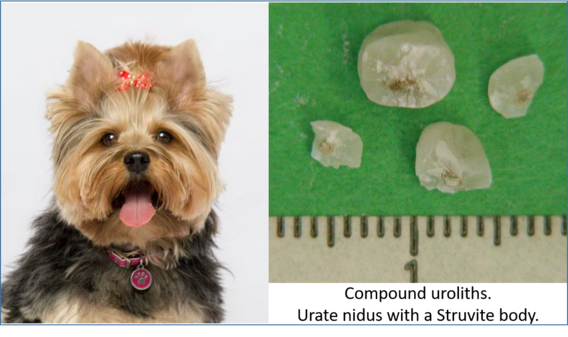Image of the month
What is the significance of urate in canine struvite stones?

The chemical composition of a urolith is a biomarker for underlying disease. A urolith composed of two calculogenic salts is an indication that two diseases are occurring simultaneously. Dogs with a struvite-urate urolith are often diagnosed with a urinary tract infection and hyperuricosuria (increased urate excretion). Most infections are caused by Staphylococcal that break down urea to ammonia. Hyperuricosuria is often caused by genetic variants in a urate transporter or hepatic insufficiently due to vascular anomalies. It is unknown if all struvite-urate stone formers fit this disease phenotype. To identify those that do, we recommend bile acid testing and genetic testing for urate transport anomalies.
How to manage these two diseases and reduce stone recurrence
- Promptly recognize and eradicate urinary tract infection.
- Eliminate risk factors (peri-vulvar dermatitis, immunosuppressive drugs, obesity, others).
- Teach owners to recognize signs of infection and to seek care early.
- Periodic urine cultures (1 month after stone removal and then every 3 to 6 months as needed).
- Determine if hyperuricosuria results from a liver or genetic disease.
- Perform serum bile acids in dogs with suspected hepatic insufficiency (Yorkshire terrier, miniature Schnauzer, Maltese, pug, shih tzu). If positive, consider nutritional, pharmacological and surgical strategies depending on disease severity.
- Submit a genetic tests for Hereditary Hyperuricosuria (vgl.ucdavis.edu/test/hyperuricosuria) in suspected breeds (e.g. bulldog, black Russian terrier, Labrador, American Staffordshire terrier, Weimaraner, others). Affected dogs may benefit from low dose allopurinol (5mg/kg daily) especially with recurrent struvite-urate stones.
- Feed low purine foods. Since most of these stones are predominantly struvite, it is tempting to feed struvitolytic diets and ignore the urate. Additional research is needed to determine if this is advantageous, especially when urate is less than 10-20% of the stone. Until then, we recommend avoiding struvitolytic diets because the urine acidification that these diets produce, promotes urate stone formation. Instead, we recommend feeding low purine diets (Derm Complete, u/d, HA Hydrolyzed, others), or liver support foods if needed (L/d, g/d, Hepatic).